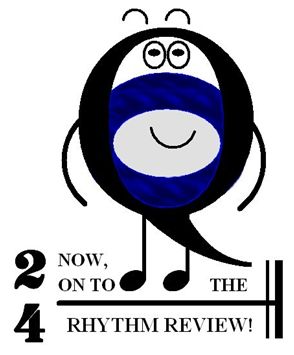I am glad that I asked Cal the Rhythm Calculator to teach Rhythm Notation. You learned a lot!
As promised, I have created an assortment of fun ways to review the information that you learned in the Rhythm Laboratory.
At this stage, everyone has reached an important milestone. You have been introduced to Rhythm Notation!
Acquiring rhythm know-how away from your instrument, makes it easier to apply it to your performances.

After the review, exercises await, so be prepared to Clap and Count!
By now, I am pretty sure that you noticed my feet are quarter notes.
In my picture, I feel perfectly at home within a 2 – 4 measure.

Practicing rhythm exercises power-up your rhythm skills, and require focus.

Rhythm Laboratory Notation Parts Note Heads Stems Beams Flags Note Construction
Common-Time Measures Bar-Lines Counting in Common-Time Whole, Half and Quarter Notes
Ties Dots Time-Signatures Q’s Rhythm Review Time-Signature Rules Beat Accent
Down-Beat and Up-Beat Conducting Patterns Cut-Time Common-Time Beat Emphasis
Three-Beat Measures Note Values Rhythm Workouts The ‘Cycle’ Note Equivalents
Counting Sub-Divisions “If You Can Say It, You Can Play It” Author’s Story Sub-Division Lingo
Quarter Notes with Eight Notes Adding Sixteenth Notes Notes Sharing Beams Beam Awareness Pointers
Triplets Triplet Workout Compound-Time Compound-Time Workout Music Rests
Rest and Note Equivalents Whole Rest Half Rest Quarter Rest Eighth Rest Sixteenth Rest
Dotted Rests Q’s Rest Review Process of Sub-Division Relating Rests to Notes Rhythm Exam Prep
Level 1 Rhythm Exam Level 2 Rhythm Exam Level 3 Rhythm Exam



